| Pages:
1
2
3
4
..
24 |
condennnsa
Hazard to Others
  
Posts: 217
Registered: 20-4-2010
Location: Romania
Member Is Offline
Mood: No Mood
|
|
Blogfast you say that Nd precipitates first, and Fe doesn't? unionised claimed the other way around...
|
|
|
unionised
International Hazard
    
Posts: 5135
Registered: 1-11-2003
Location: UK
Member Is Offline
Mood: No Mood
|
|
Fe+++ will ppt first, then Nd+++ then Fe++ so it depends on whether or not you oxidise the stuff.
I'd go with oxidising it with peroxide or some such. That way you can take out the last of the Fe with ether. Also, the Fe++ will oxidise in air so
you might as well go along with that.
|
|
|
blogfast25
International Hazard
    
Posts: 10562
Registered: 3-2-2008
Location: Neverland
Member Is Offline
Mood: No Mood
|
|
Quote: Originally posted by unionised  | Fe+++ will ppt first, then Nd+++ then Fe++ so it depends on whether or not you oxidise the stuff.
I'd go with oxidising it with peroxide or some such. That way you can take out the last of the Fe with ether. Also, the Fe++ will oxidise in air so
you might as well go along with that. |
Unionised, what makes you think Fe(III) falls first? Fe (III) sulphate is very water soluble. And we are talking about a sulphate based separation
method (based on the poor cold solubility of Nd sulphate), not a hydroxide based method...
As regards washing with ether, FeCl3 is highly soluble in acetone too: a lot cheaper than ether!
[Edited on 12-7-2011 by blogfast25]
|
|
|
condennnsa
Hazard to Others
  
Posts: 217
Registered: 20-4-2010
Location: Romania
Member Is Offline
Mood: No Mood
|
|
When I originally asked unionised which falls first I was referring to adding NaOH to the solution of chlorides...
I thought that if what he said was indeed true, it would be very easy to obtain very pure neodymium hydroxide.
So which precipitates first? and why?
|
|
|
Megamarko94
Hazard to Self
 
Posts: 68
Registered: 31-12-2010
Member Is Offline
Mood: No Mood
|
|
is NdCl3 soluble in methanol and acetone
[Edited on 12-7-2011 by Megamarko94]
|
|
|
blogfast25
International Hazard
    
Posts: 10562
Registered: 3-2-2008
Location: Neverland
Member Is Offline
Mood: No Mood
|
|
Condennsa:
I doubt very much if selective precipitation of the hydroxides of Fe (III), Nd and Fe (II) is really practical. Unionised is probably going by
solubility constants (Ksp) of these substances but I doubt if they are substantially different enough to allow selective precipitation. In any case
selective precipitation of hydroxides requires tight control of solution pH.
Here's the deal: you look up the Ksp values for Fe(OH)3, Nd(OH)3 and Fe(OH)2 and I'll do the calculation for ya. Howzat?
With sulphates, you KNOW a cold water insoluble Nd sulfato complex separates out.
Oooopsie.... 
Edit: I believe Fe3+ and Fe2+ would precipitate together as hydrated Magnetite (Fe3O4), see also preparation of ferrofluids.
The K<sub>sp</sub> = [Fe3+]x[OH-]<sup>3</sup> of Fe(OH)3 is 2.8 x 10<sup>-39</sup>, very low indeed. The
precipitation behaviour of Fe3+ in alkaline conditions may also be more complex due to various hydroxy species. And I can't find a value for
Nd(OH)3...
[Edited on 13-7-2011 by blogfast25]
|
|
|
MrHomeScientist
International Hazard
    
Posts: 1806
Registered: 24-10-2010
Location: Flerovium
Member Is Offline
Mood: No Mood
|
|
blogfast25,
Farther up the thread you mentioned an oxalate separation route - what does that entail? I know iron oxalate is insoluble, as I've prepared it before,
but is Nd oxalate soluble? Is that how you separate the two?
I've got some oxalic acid (boat wood cleaning product), and I'd like to try this procedure to ultimately arrive at Nd metal for my element collection.
|
|
|
blogfast25
International Hazard
    
Posts: 10562
Registered: 3-2-2008
Location: Neverland
Member Is Offline
Mood: No Mood
|
|
Quote: Originally posted by MrHomeScientist  | blogfast25,
Farther up the thread you mentioned an oxalate separation route - what does that entail? I know iron oxalate is insoluble, as I've prepared it before,
but is Nd oxalate soluble? Is that how you separate the two?
I've got some oxalic acid (boat wood cleaning product), and I'd like to try this procedure to ultimately arrive at Nd metal for my element collection.
|
I've never tried this method but it's in fact neodymium oxalate that’s insoluble, both ferrous and ferric oxalates being soluble. So the separation
is based on that. Neodymium oxalate can then be calcined to Nd2O3 and redissolved into a strong acid.
Oxalic acid is very easy to purify by means of recrystallisation. Get rid of the .2H2O by heating to about 100 C.
|
|
|
MrHomeScientist
International Hazard
    
Posts: 1806
Registered: 24-10-2010
Location: Flerovium
Member Is Offline
Mood: No Mood
|
|
Quote: Originally posted by blogfast25  |
I've never tried this method but it's in fact neodymium oxalate that’s insoluble, both ferrous and ferric oxalates being soluble. So the separation
is based on that. Neodymium oxalate can then be calcined to Nd2O3 and redissolved into a strong acid.
Oxalic acid is very easy to purify by means of recrystallisation. Get rid of the .2H2O by heating to about 100 C. |
Really? I could have sworn iron oxalate precipitated when I did it. Ah well, that was over a year ago and I didn't keep notes back then, so I'm sure
I've forgotten much of the procedure.
I'll definitely give this a try, and report back with what I find.
The (rough) plan is:
- HD magnets + H<sub>2</sub>SO<sub>4</sub> to get sulfates
- filter off the boron
- sulfates + NaOH to precipitate hydroxides
- hydroxides + oxalic to precipitate & separate Nd oxalate
- heat the oxalate to form Nd<sub>2</sub>O<sub>3</sub>
- use this in a thermite-like reaction with Mg powder to finally end in Nd metal (or convert to NdCl<sub>3</sub> with acid, then to
NdF<sub>3</sub> with NaF, and thermite that, as you suggested in another thread)
Hm, seems like there should be an easier route. I'll think about it.
[Edited on 7-14-2011 by MrHomeScientist]
|
|
|
blogfast25
International Hazard
    
Posts: 10562
Registered: 3-2-2008
Location: Neverland
Member Is Offline
Mood: No Mood
|
|
Quote: Originally posted by MrHomeScientist  |
I'll definitely give this a try, and report back with what I find.
The (rough) plan is:
- HD magnets + H<sub>2</sub>SO<sub>4</sub> to get sulfates
- filter off the boron
- sulfates + NaOH to precipitate hydroxides
- hydroxides + oxalic to precipitate & separate Nd oxalate
- heat the oxalate to form Nd<sub>2</sub>O<sub>3</sub>
- use this in a thermite-like reaction with Mg powder to finally end in Nd metal (or convert to NdCl<sub>3</sub> with acid, then to
NdF<sub>3</sub> with NaF, and thermite that, as you suggested in another thread)
Hm, seems like there should be an easier route. I'll think about it.
[Edited on 7-14-2011 by MrHomeScientist] |
Couple of comments:
Sulphates should already separate Nd (insoluble sulfato complex) from iron.
Magnesiothermy on Nd2O3 is unlikely to yield enough energy to obtain a molten mass of Nd metal + liquid MgO: you end up with a useless sintered mass
of Nd metal in MgO sinter. Al cannot reduce Nd2O3 (ΔG > 0).
Only reduction of NdF3 with Mg is the best option (or electrolysis of a molten Nd salt).
NaF is very poorly water soluble: better to use NH4HF2 (CAUTION! Highly soluble fluorides are dangerous!)
|
|
|
MrHomeScientist
International Hazard
    
Posts: 1806
Registered: 24-10-2010
Location: Flerovium
Member Is Offline
Mood: No Mood
|
|
Quote: Originally posted by blogfast25  |
Couple of comments:
Sulphates should already separate Nd (insoluble sulfato complex) from iron.
Magnesiothermy on Nd2O3 is unlikely to yield enough energy to obtain a molten mass of Nd metal + liquid MgO: you end up with a useless sintered mass
of Nd metal in MgO sinter. Al cannot reduce Nd2O3 (ΔG > 0).
Only reduction of NdF3 with Mg is the best option (or electrolysis of a molten Nd salt).
NaF is very poorly water soluble: better to use NH4HF2 (CAUTION! Highly soluble fluorides are dangerous!)
|
Hrm. If that's the case, then what's the benefit of using the oxalate separation vs sulfuric acid? Either way you'd have to get rid of the elemental
boron somehow.
Thanks a lot for the tips on the thermite. I wanted to use NaF because it's cheaper, but I see now you're right about solubility. I'll take maximum
precautions when using the ammonium salt. Would you recommend using NH<sub>4</sub>HF<sub>2</sub> or
NH<sub>4</sub>F?
[Edited on 7-14-2011 by MrHomeScientist]
|
|
|
blogfast25
International Hazard
    
Posts: 10562
Registered: 3-2-2008
Location: Neverland
Member Is Offline
Mood: No Mood
|
|
Quote: Originally posted by MrHomeScientist  | Hrm. If that's the case, then what's the benefit of using the oxalate separation vs sulfuric acid? Either way you'd have to get rid of the elemental
boron somehow.
Thanks a lot for the tips on the thermite. I wanted to use NaF because it's cheaper, but I see now you're right about solubility. I'll take maximum
precautions when using the ammonium salt. Would you recommend using NH<sub>4</sub>HF<sub>2</sub> or
NH<sub>4</sub>F?
[Edited on 7-14-2011 by MrHomeScientist] |
NH4HF2 packs more F<sup>-</sup> per mol. It's probably proportionally and arguably more dangerous than NH4F. Still, they're usable, just
take good precautions and keep yer wits about at all times. Have a back up plan in case of emergency... And use plasticware, not glass!
[Edited on 14-7-2011 by blogfast25]
|
|
|
kmno4
International Hazard
    
Posts: 1517
Registered: 1-6-2005
Location: Silly, stupid country
Member Is Offline
Mood: No Mood
|
|
Quote: Originally posted by blogfast25  |
I've never tried this method but it's in fact neodymium oxalate that’s insoluble, both ferrous and ferric oxalates being soluble.
|
As I mentioned, Fe must be in Fe(III) form. In another case, Fe(II) oxalate will precipitate. You can try this with FeSO4 and (COOH)2 - reaction takes
some time, but soon you will get Fe(COO)2 sediment.
Nd oxalate can be recrystallized from hot 50% HNO3. This is quite unusuall, and shows how stable is Nd oxalate.
|
|
|
blogfast25
International Hazard
    
Posts: 10562
Registered: 3-2-2008
Location: Neverland
Member Is Offline
Mood: No Mood
|
|
Thanks kmno4, very interesting...
|
|
|
MrHomeScientist
International Hazard
    
Posts: 1806
Registered: 24-10-2010
Location: Flerovium
Member Is Offline
Mood: No Mood
|
|
Well I did this experiment as far as getting neodymium sulfate, and here are my observations. Unfortunately, I didn't take any pictures until the end.
I started by demagnetizing a single hard drive magnet by directly heating it in a propane torch flame. After this I broke it into chunks and peeled
off as much of the Ni coating as I could. These pieces weighed 9.4g.
I reacted this with 40mL of 4.4M battery-grade sulfuric acid. It immediately started reacting to form the sulfates via:
Nd<sub>2</sub>Fe<sub>14</sub>B + 17H<sub>2</sub>SO<sub>4</sub> == 14FeSO<sub>4</sub> +
Nd<sub>2</sub>(SO<sub>4</sub> <sub>3</sub> + B +
17H<sub>2</sub> <sub>3</sub> + B +
17H<sub>2</sub>
(it turns out that boron isn't as unreactive as I thought, which I'll get to later)
After the reaction, the solution was very dark with a whitish crystalline precipitate. I diluted this down to 150mL to get everything into solution.
Then I went through a number of heating and cooling cycles to exploit neodymium sulfates inverse solubility behavior (less soluble in hot soln.) and
separate it from the other products. First I cooled it in an ice bath to filter off any unreacted B, leftover Ni coating, and any
FeSO<sub>4</sub> that happened to precipitate. Then, I heated the solution to near boiling. When it had evaporated down to ~60mL, pink
crystals started forming. These were filtered off while still hot.
After the solution cooled, a lot of iron sulfate had crystallized into this really neat looking little mountain of crystals.
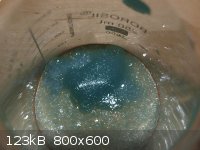
After a few more cycles of heating and filtering the neodymium sulfate to get it out of solution and then finally recrystallize and purify it, I ended
up with 1.4g total product. As reported before, it looks different under different lighting which is pretty cool to see. The first picture is in
fluorescent tube lighting, and the second is outside in daylight.
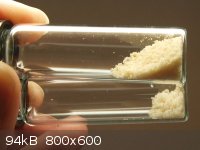
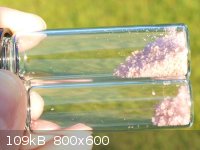
The bottom vial contains 0.2g of what appeared to be somewhat more pure material. Overall, yield was pretty meager considering stoichiometrically I
should have gotten 5g (based on that equation above).
While I was collecting the FeSO<sub>4</sub> crystals, I noticed some thin, clear , flaky crystals clinging to them. These looked pretty
different, so I recovered maybe 50mg of them. I suspect these are boric acid, so I dissolved them in methanol and set it on fire to look for the
characteristic green of trimethyl borate. It didn't show up that well, but you can see it definitely has a green tint to it.
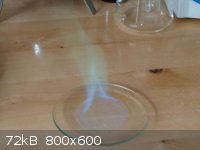
That strongly suggests it's boric acid, which I didn't think would have been formed. Checking around, I did find that the wiki page for boron states
"When finely divided, it [boron] is attacked slowly by ... hot sulfuric acid..." so that seems to support my hypothesis. I'm not exactly sure what the
products of B + H2SO4 are, but the flame test closely follows my experience with boric acid. At the very least we can say that some of the boron
reacts into some soluble white compound.
I've got some ammonium bifluoride on order, and once that arrives I'll continue with the next step towards elemental neodymium metal. The goal is to
make NdF<sub>3</sub>, then thermite that with magnesium dust to obtain the metal. Would I be able to react the bifluoride straight with
Nd<sub>2</sub>SO<sub>4</sub> or do I need to convert it to the hydroxide or something? What would that reaction's equation be?
I'm not too familiar with fluoride chemistry (I've seen it mentioned often that it's different than the other halides). I already asked this question
in beginnings, but I hadn't gotten any replies yet. Thanks, and I hope this post was informative.
|
|
|
unionised
International Hazard
    
Posts: 5135
Registered: 1-11-2003
Location: UK
Member Is Offline
Mood: No Mood
|
|
Quote: Originally posted by blogfast25  | Condennsa:
I doubt very much if selective precipitation of the hydroxides of Fe (III), Nd and Fe (II) is really practical. Unionised is probably going by
solubility constants (Ksp) of these substances but I doubt if they are substantially different enough to allow selective precipitation. In any case
selective precipitation of hydroxides requires tight control of solution pH.
Here's the deal: you look up the Ksp values for Fe(OH)3, Nd(OH)3 and Fe(OH)2 and I'll do the calculation for ya. Howzat?
With sulphates, you KNOW a cold water insoluble Nd sulfato complex separates out.
Oooopsie.... 
Edit: I believe Fe3+ and Fe2+ would precipitate together as hydrated Magnetite (Fe3O4), see also preparation of ferrofluids.
The K<sub>sp</sub> = [Fe3+]x[OH-]<sup>3</sup> of Fe(OH)3 is 2.8 x 10<sup>-39</sup>, very low indeed. The
precipitation behaviour of Fe3+ in alkaline conditions may also be more complex due to various hydroxy species. And I can't find a value for
Nd(OH)3...
[Edited on 13-7-2011 by blogfast25] |
Actually, I was relying on the fact that I have done the experiment; it's quite easy to ppt the Fe+++ selectively and leave the Nd in solution. I
found a value for the solubility product here
http://pubs.acs.org/doi/abs/10.1021/ja01547a011
where they say it's of the order of 10^-21
The difference in solubility product is about 18 orders of magnitude; I found that to be sufficient. The fact that one product is brown and the other
is white also helps.
|
|
|
blogfast25
International Hazard
    
Posts: 10562
Registered: 3-2-2008
Location: Neverland
Member Is Offline
Mood: No Mood
|
|
MrHomeChemist:
Nice work.
Can you describe the heating/cooling cycles a little more?
Boron probably reacts with concentrated sulphuric acid, forming boric acid or boric oxide, depending on water being present. But with relatively weak
sulphuric acid? I doubt that. The green does seem to suggest it but ideally you’d have to identify a determining spectral line to confirm the green
is boron. In my case the boron was found as a brown amorphous powder.
For making the NdF3, I’d suggest adding the right amount of NH4HF2 to a solution of Nd<sup>3+</sup> salt.
But actually making such small magnesiothermic reactions work is difficult. I suggest you buy some Nd salt to take this further. Or repeat the
procedure but looking after yield better…
Unionised:
I cannot read the value of Ks for Nd(OH)3 in the introduction of that paper but lower down it says the solubility of Nd(OH)3 is 2.7 x
10<sup>-4</sup> and that would suggest a Ks of 1.4 x 10<sup>-13</sup>. That would require a pH of between 9 and 10 for
precipitation of Nd(OH)3 to start, way after Fe(OH)3 would drop out. As a separation method between Nd3+ and Fe3+ I’ve never heard of it before
though…
How did you control pH? Because go a little too far and your Nd will fall. Buffer?
|
|
|
kmno4
International Hazard
    
Posts: 1517
Registered: 1-6-2005
Location: Silly, stupid country
Member Is Offline
Mood: No Mood
|
|
As it was mentioned in other posts - if Nd salt is not purely white (colourless) in fluorescent lamp, then it is not pure (Pr gives green colour).
Also strong heating should give blue powder of Nd2O3. The same - if it is not blue, it not pure. My samples of magnets contain Nd+Pr.
|
|
|
MrHomeScientist
International Hazard
    
Posts: 1806
Registered: 24-10-2010
Location: Flerovium
Member Is Offline
Mood: No Mood
|
|
Quote: Originally posted by blogfast25  | MrHomeChemist:
Nice work.
Can you describe the heating/cooling cycles a little more?
Boron probably reacts with concentrated sulphuric acid, forming boric acid or boric oxide, depending on water being present. But with relatively weak
sulphuric acid? I doubt that. The green does seem to suggest it but ideally you’d have to identify a determining spectral line to confirm the green
is boron. In my case the boron was found as a brown amorphous powder.
For making the NdF3, I’d suggest adding the right amount of NH4HF2 to a solution of Nd<sup>3+</sup> salt.
But actually making such small magnesiothermic reactions work is difficult. I suggest you buy some Nd salt to take this further. Or repeat the
procedure but looking after yield better… |
Sure, always happy to provide more detail! After the pieces were done reacting with the sulfuric acid, the solution was quite dark and somewhat
lavender (in outside lighting of course). I first chilled this in an ice bath to get the Nd into solution, and filtered off the remaining pieces of Ni
coating and some boron powder. The boron was very fine and brown, as you described. After letting the solution sit overnight, nearly all of the
'darkness' had settled out of the solution, presumably very fine boron powder. There was only a tiny amount of this. I carefully decanted to get rid
of the remaining B.
Next, I heated the solution to near boiling. Once it had reduced in volume to about 60mL, a pink powder precipitated. After it had went down to 50mL,
I stopped heating and filtered this off while still hot. After the solution cooled, that mound of iron sulfate had crystallized.
Decanting the solution from that, I heated it again to near boiling. After another small reduction in volume, more pink precipitate formed. I hot
filtered this again. I repeated this process about 4 times total to try to squeeze out as much Nd as possible, topping it up with some extra water
when the volume got low and I was worried Fe would start dropping out too.
After all this, my product was heavily contaminated with FeSO<sub>4</sub> because I didn't think to wash the powder with hot water while
it was on the filter. So, I once again immersed my product (about 5g) in about 50mL of water, heated, filtered, and rinsed with hot water. That's how
I arrived at my final amount of 1.4g of much cleaner pink crystals.
As far as yield goes, I feel like I did quite a bit to get as much out as possible. I suppose some could be trapped in the
FeSO<sub>4</sub> crystals, as I did notice some pink clinging to some of them. It might be worth another trip into solution.
As for the B, as I mentioned above I did get some in elemental form and also some in those white flaky crystals (at least, I suspect it's a B
compound). I wonder if one of those cheapo CD spectrometers would be enough to tell me something about the composition? It could be worthwhile to
build one. I did just finish a box of cereal this morning 
Finally, concerning the final steps: If I do need Nd in solution, I'll plan on using this route:
Nd<sub>2</sub>(SO<sub>4</sub> <sub>3</sub>(s)
--> Nd(OH)<sub>3</sub>(s) --> NdCl<sub>3</sub>(aq) --> NdF<sub>3</sub>(s) <sub>3</sub>(s)
--> Nd(OH)<sub>3</sub>(s) --> NdCl<sub>3</sub>(aq) --> NdF<sub>3</sub>(s)
That's assuming the bifluoride will replace chloride, via something like
2NdCl<sub>3</sub> + 3NH<sub>4</sub>HF<sub>2</sub> == 2NdF<sub>3</sub> + 3NH<sub>4</sub>Cl
+ 3HCl
Don't quote me on that reaction, I don't know if it's really reasonable. I suppose I could just try to dissolve the sulfate in cold water and just use
that instead.
I wonder, perhaps I should have just started with hydrochloric acid instead of sulfuric? So I could go straight to NdCl<sub>3</sub>. It
might be more difficult to separate from iron chloride, though. In any case, I have a bunch of HD magnets donated by coworkers to the cause so I hope
to get a decent amount of product from all that. Hopefully enough to make a 'thermite' large enough to work.
|
|
|
unionised
International Hazard
    
Posts: 5135
Registered: 1-11-2003
Location: UK
Member Is Offline
Mood: No Mood
|
|
I didn't control the pH as such. I added NaOH soln slowly and stopped when the ppt stopped being brown.
I don't know if this image will work, but it's the Ksp data
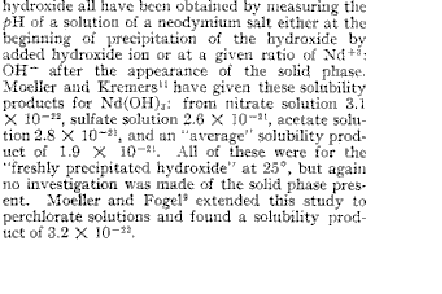
[Edited on 22-7-11 by unionised]
|
|
|
blogfast25
International Hazard
    
Posts: 10562
Registered: 3-2-2008
Location: Neverland
Member Is Offline
Mood: No Mood
|
|
MrHomeChemist:
Thanks. You seem to have done everything right, despite the low yields.
Precipitating the NdF3 from cold sulphate should be fine. Use fairly dilute solutions to avoid occlusion (co-precipitation).
Unionised:
Something doesn't tally with their Ksp and solubility: a quoted solubility of Nd(OH)3 of 2.7 x 10<sup>-4</sup> mol/l works out as a Ksp of
1.4 x 10<sup>-13</sup>.
And a Ksp of 1.9 x 10<sup>-21</sup> means Nd(OH)3 would start precipitating (from a 1 M solution of Nd3+) from about pH = 7. That doesn't
sound right to me: Nd salts aren't very prone to hydrolysis, IIRW...
I'm guessing your method worked and that a value of Ksp = 1.4 x 10<sup>-13</sup> is closer to reality...
A solubility of 2.7 x 10<sup>-4</sup> mol/l means [Nd] = 2.7 x 10<sup>-4</sup> and [OH-] = 3 x 2.7 x
10<sup>-4</sup> (at that concentration dissociation of water can be ignored), so Ksp = 27 x 2.7<sup>4</sup> x
10<sup>-16</sup> = 1.4 x 10<sup>-13</sup>.
|
|
|
MrHomeScientist
International Hazard
    
Posts: 1806
Registered: 24-10-2010
Location: Flerovium
Member Is Offline
Mood: No Mood
|
|
blogfast:
Thanks for the encouragement, tips, and for checking my procedure. I don't have much formal education in chemistry (my degree was in physics), so I'm
always concerned I'm missing some crucial step or doing something incorrectly. Because of that I also don't have as much background in the theory as
I'd like. So once again, thanks for the support.
This weekend I plan to dissolve the rest of my magnets and isolate more Nd2(SO4)3. I'll post here if anything interesting happens.
|
|
|
MrHomeScientist
International Hazard
    
Posts: 1806
Registered: 24-10-2010
Location: Flerovium
Member Is Offline
Mood: No Mood
|
|
I read kmno4's reply concerning Pr contamination, and did some searching to see what could be done about that. I found some really interesting
procedures on google books in The metals of the rare earths, by James Frederick Spencer.
Double nitrate salts are what interested me, to separate didymium into its constituent Nd and Pr fractions. Different types of double nitrates are
discussed: p.26 - ammonium, p.28 - magnesium, and p.31 - manganese.
Manganese nitrates sound like the best for our project here, but of course has the least information on it. I assume it to be similar to the magnesium
nitrate procedure, which I'll quote here:
| Quote: |
ii) Double Magnesium Nitrates.—The crystallisation of the double magnesium nitrates of the rare earths was introduced by Drossbach227 for the
separation of neodymium and praseodymium. The cerium earths form double nitrates with magnesium nitrate of the general formula
2M1n(N03)3,3Mg(N03)2,24H20. The material used by him for this separation was a didymium lanthanum fraction obtained by the oxychloride method (II.
(/), p. 44). The mixture was converted into oxides which were then dissolved in nitric acid; the same quantity of nitric acid was treated with as much
magnesia as it would dissolve, and the two solutions were mixed. This ensures the addition of exactly the correct amount of magnesium nitrate for the
formation of the double salts. The mixed solution was then heated and small quantities of magnesia added until the solution was alkaline to congo
paper. 0n diluting the solution, impurities such as iron, manganese, aluminium, silica, and phosphoric acid were precipitated by the excess of
magnesia. The solution was then filtered and concentrated until practically the whole of the double nitrates had separated out, The crystals were
removed from the mother liquor, placed in a dish and treated with boiling water until only a small portion remained undissolved. Cooling was then
brought about byNfloating the dish in water at 30°-40°, and a small quantity of cold water was sprayed on to the surface of the solution. A quantity
of large crystals separated on the bottom of the dish, and as soon as about one-tenth of the total earths had crystallised out, the liquor was poured
from the crystals into a second dish which was floated on water at 10°-15° and cooled on the surface as before when a second crop of crystals was
obtained. The mother liquor from the second crop of crystals was then treated at o° in the same way, and a third crop of crystals obtained. The
mother liquor from the third crop of crystals was concentrated and the process repeated. The final mother liquor being rejected for this purpose was
used for the isolation of erbium, samarium, yttrium, and gadolinium which it contained. The various crops of crystals were then recrystallised
systematically when the following materials were obtained: neodymium containing traces of praseodymium, a little pure neodymium, and much lanthanum
containing praseodymium. The double magnesium nitrates of the rare earths crystallise from water in the order228, 229 lanthanum, praseodymium,
neodymium, excess magnesium nitrate, samarium, europium, erbium, gadolinium, and yttrium, and the remaining yttrium earths. By using this method,
Feit230 was able to concentrate terbium from a mixture of monazite earths in the least soluble fraction, and James 225 uses it for the initial
separation of the cerium earths.
|
Since I don't know the extent of Pr contamination in these magnets, and I'll be working with fairly small quantities, multiple recrystallizations like
this might be overkill. Still, very interesting to read about.
|
|
|
blogfast25
International Hazard
    
Posts: 10562
Registered: 3-2-2008
Location: Neverland
Member Is Offline
Mood: No Mood
|
|
MrHomeScientist:
While these methods are interesting from a chemical point of view, they are difficult to carry out by hobbyists because most of us have no easy way to
monitor progress of separation: that really requires decent spectroscopy (of one form or another).
Today the separation is mainly carried out by means of tailored ion exchange resins, by exploiting the lanthanide contraction, I believe…
For my own sample of NdCl3 I have some circumstantial evidence that Pr is present. Time allowing (one fine day!) I’ll push on with making more of
this stuff from neomagnets (they are really cheap nowadays) and ignore the Pr impurity and try and make the metal by reduction of (Nd,Pr)F3 with Mg.
But ample experience with thermites shows that reaction batches of less than 20 g (in open crucible conditions) yield little usable metal.
If you push on and succeed it’ll be a physicist to prepare the first metallic Nd on this forum!
|
|
|
MrHomeScientist
International Hazard
    
Posts: 1806
Registered: 24-10-2010
Location: Flerovium
Member Is Offline
Mood: No Mood
|
|
I did quite a bit of work over the weekend on this. It takes a very long time to get to neodymium sulfate - peeling off the nickel coating takes
forever, dissolving in acid takes at least a few days, and trying to recover the sulfate is extremely slow because of my multiple heating and cooling
cycles. I never want to boil away too much water because it reaches saturation of the FeSO4 and that could start dropping out as well. It also tends
to bump pretty violently once some powder precipitates out.
I'm almost done processing another batch of magnets, and the neodymium sulfate I'm getting is quite a bit different than in my initial batch. Overall
it is much, much more lavender than before and doesn't change colors nearly as much in different lighting. It's also coming out in many different
shades each time I recover a bit more from the solution. Each time I would heat the solution and collect the crystals that formed, they would come out
different colors. Here's a picture: the two on the left are the ones from my first run as seen above, here for comparison. This is under fluorescent
tube lighting in my kitchen.
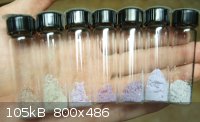
Any ideas to why the different shades of color? I wonder if it's just due to different crystal sizes? Larger grains seem to have a more rich color.
Regardless, all the colors are quite different from the initial batch and they aren't nearly as affected by lighting conditions either.
Something else interesting: I got a bunch of magnets donated by some coworkers, including some really thick old hard drive magnets. While just as
powerful, I suspected that these might not be neodymium so I dissolved one separately from the thinner magnets I've been using. It dissolved with
about the same amount of precipitated gunk as the other magnets, but the solution was green instead of lavender. Here's what it looks like, compared
to the purple of a "normal" run:
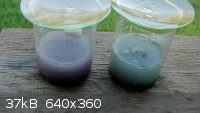
I suspect it's samarium cobalt (when the coating is peeled off it looks identical to Nd magnets), but I have yet to process it further to investigate.
I spent enough time on the one on the left (it's what produced the vials from above).
Finally, I wasn't kidding when I said I had a bunch of magnets donated:
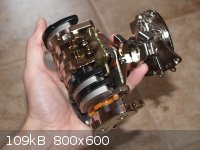
Many of them are the thicker variety, so I don't know if they will work for this experiment. In any case, I've got a lot of material to work with!
|
|
|
| Pages:
1
2
3
4
..
24 |